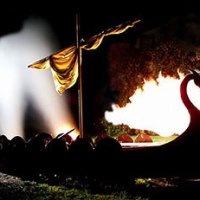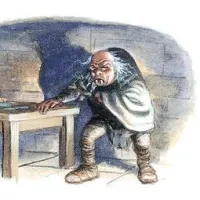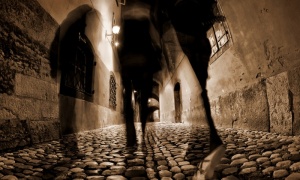Literary fame seems almost like a lottery; ghost story writers in particular seem to pick losing tickets more than any other kind of author. It is an interesting exercise to ponder why certain authors and their works in this vein, just as well equipped to stand the test of time as their contemporaries, fall into speedy obscurity, while others stay in the public eye. The Victorian era is a fine example of this – for every tale of terror that has survived in print today, there are a hundred languishing in undeserved obscurity. Bernard Capes is a case in point. During his writing career, he published forty-one books, contributed to all the leading Victorian magazines, and left behind some of the most imaginative tales of terror of his era – yet within ten years of his death, he had slipped down the familiar slope into total neglect. Until the early 1980s, Capes seldom appeared in reference works in this (or any other) field of literature, and even histories of Victorian writers published in his lifetime give him scant mention. He was overlooked by every anthologist in this genre from his death in 1918 right up until 1978: sixty years of lingering in the dark while many of his contemporaries were brought back to light. I would place Capes among the most imaginative writers of his day. He turned out plot after plot worthy of the recognition accorded to such contemporaries as Stevenson, Haggard, and Conan Doyle, all of whom are still in print today. This selection of his stories help put Capes in his deserved position with the leading talents of Victorian fantasy.
Bernard Edward Joseph Capes was born in London on 30 August 1854, a nephew of John Moore Capes, a prominent figure in the Oxford Movement. He was educated at Beaumont College and brought up as a Catholic. His elder sister, Harriet Capes (1849–1936), was to become a noted translator and writer of children’s books, publishing a dozen or more up to 1932. As we will see, a very awkward angel perched on Capes’s shoulder all his life and it was only at the age of forty-three that he found his true vocation. In 1897 he entered a competition for new authors organised by the Chicago Record. Capes came second with his novel The Mill of Silence, published in Chicago that year by Rand, McNally. Obviously heartened by this turn of events, Capes entered the competition in 1898 when the Chicago Record repeated it. This time he hit the jackpot. His entry, The Lake of Wine – a long, sometimes quite macabre tale of a fabulous ruby bearing the title of the book – won the competition. It was published by Heinemann the same year, and Capes was a writer from then on. And write he did. Out flooded short stories, articles, newspaper editorials, reviews, and novels. He published a further two in 1898 (including the book bearing one of the most unappetising titles of all time: The Adventures of the Comte de la Muette During the Reign of Terror). All through the early 1900s, with a four-book bulge in 1910, and right up through the First World War, Capes knocked out a couple of books every year. Each novel took three months to write, working six hours a day, and Capes would take a month’s holiday after finishing the book. He also played the piano and made games for his children. Another great interest was painting and illustrating. He wrote mainly novels, but every so often he issued a book of his stories collected from their various magazine appearances. The list of magazines he contributed to is impressive, and includes Blackwood’s, Cassell’s, Cornhill, The Idler, Illustrated London News, Lippincott’s, Macmillan’s, Pall Mall and Pearson’s: a roll of honour of the finest magazines of the era.
Even during his period of literary success, Bernard Capes’s angel was never far away. With a new novel on the stocks (The Skeleton Key, published posthumously), Capes was struck down by the influenza epidemic which swept Europe at the end of the First World War. A short illness was followed by heart failure, and he died in Winchester on 1 November 1918. He was sixty-four, and had had only twenty years at writing. Capes’s luck, as always, ran out at the wrong time. His wife Rosalie organised a plaque for him in Winchester Cathedral, among the likes of Isaac Walton and Jane Austen. It can still be seen, next to the entrance to the crypt. He had earned enough of a reputation to merit an obituary in The Times on 4 November 1918. It called him a ‘busy writer, and always a readable one … as he grew older, his style mellowed, for gifted as he was he took some time to find himself’; then added, in typically sniffy fashion, ‘Nor were his The Fabulists, a collection of eerie tales, unworthy of him.’ This fastidious approach to tales of terror is very familiar, even now; Capes probably had to bear his share of literary snobbery in his lifetime. Ghost stories are always treated as a poor relation by literary thinkers, although heaven knows why – they are one of the longest surviving branches of literature. Capes received a less snooty obituary from The New Witness, which called him ‘one of our most brilliant contributors’. It said of him that ‘He had a very real genius for the supernatural, his ghost stories are among the best in the language. He had an eerie gift for touching on the very quick of horror and never spoilt a supernatural situation by the suggestion of materialism.’ Capes had also earned the enthusiasm of G.K. Chesterton, who wrote an introduction for Capes’s posthumous The Skeleton Key (a fine detective novel). Chesterton said of Capes; ‘It may seem a paradox to say that he was insufficiently appreciated because he did popular things well. But it is true to say that he always gave a touch of distinction to a detective story or a tale of adventure; and so gave it where it was not valued, because it was not expected.’ Chesterton obviously knew about the sniffy tones of the day as well. He praised Capes’s ‘technical liberality of writing a penny-dreadful so as to make it worth a pound. In his short stories … he did indeed permit himself to be poetic in a more direct and serious fashion.’ And it is those stories which concern us now.
Capes’s imagination soared. He imagined the moon being the repository of lost souls (‘The Moon Stricken’); the soul of a dead glassblower trapped in a bottle and released to terrorise a foolish investigator (‘The Green Bottle’); a smuggler brought down by the man whose death he caused twenty years earlier (‘Dark Dignum’); a werewolf priest in a grisly variation of ‘Little Red Riding Hood’ (‘The Thing in the Forest’); a prison cell haunted by a dead man who makes the dust swirl constantly (‘An Eddy on the Floor’); a suicide returning to teach his ne’er-do-well nephew a grisly lesson (‘The Closed Door’); and a wicked ancestor who steps down from his portrait to give visitors a guided tour (‘A Queer Cicerone’). He ranged from Napoleonic terrors to haunted typewriters; from marble hands which come to life to plague-stricken villagers haunted by a scythe-wielding ghost; from werewolves to the Wandering Jew. Bernard Capes rang the changes on tales of terror like very few writers of his day. It makes his neglect all the more surprising. Of the tales in this book, nearly all appeared first in magazine form and were then collected into various books of short stories as Capes published them. Those from The Fabulists need some explanation. The shorter stories first appeared in The New Witness, and were tales told by four young men who decide to journey from village to village telling stories to earn their keep. They merely narrate the tales, without necessarily appearing in them; but the stories all bear the marks of a camp-fire yarn. As for the others, they stand up superbly on their own. Capes could hit the mark better than most.
If you examine Capes’s tales, you won’t find any conventional heroes or conventional happy endings. His protagonists wander into situations or are obliged to take action almost by default, while suffering humanity gets short shrift as well. He also seems to reserve harsh fates for gentlemen of the press – consider ‘The Green Bottle’, ‘An Eddy on the Floor’, or ‘William Tyrwhitt’s “Copy”’. Capes hardly needed to populate the moon with lost souls – he sends them wandering blindly through the pages of his stories down here on earth. Perhaps it is his basic pessimism that gives Capes’s stories their undoubted power. Few authors from the time conjured up such dark canvasses as he paints in ‘A Gallows-bird’ or ‘The Sword of Corporal Lacoste’. However, this dark vision never seemed to extend to his novels, which are often lighter, less grim, historical follies. The Pot of Basil (1913), for instance, is an airy, whimsical piece about eighteenth century court life in Italy – a long way from the grinding horror of ‘A Gallows-bird’. And the lovers in The Story of Fifine (1914) are in a world far removed from the blossoming courtship we see outlined in ‘The Accursed Cordonnier’. Capes soon passed into the neglect so common in this field. After The Skeleton Key was published in 1919, nothing more appeared in Britain until a couple of re-issues in 1928 and 1929 – and then that was it. His neglect over the years is strange indeed, especially when other authors from the same era are reprinted mercilessly. I hope that this will bring Bernard Capes back into the eye of the ghost story enthusiast, and a wider public. He deserves reprinting and a second chance. We must hope that his usual bad luck died with him.

















Nice story..
If you like motivation $ education story.
Please follow Me.!
Hi is it still possible to pick up a copy of the black reaper or is it out of print now.Regards
I believe it has recently been reissued both as an ebook and paperback. Another of his anthologies is available as a free pdf here: https://gothictexts.wordpress.com/2014/12/19/at-a-winters-fire-1899-by-bernard-capes/